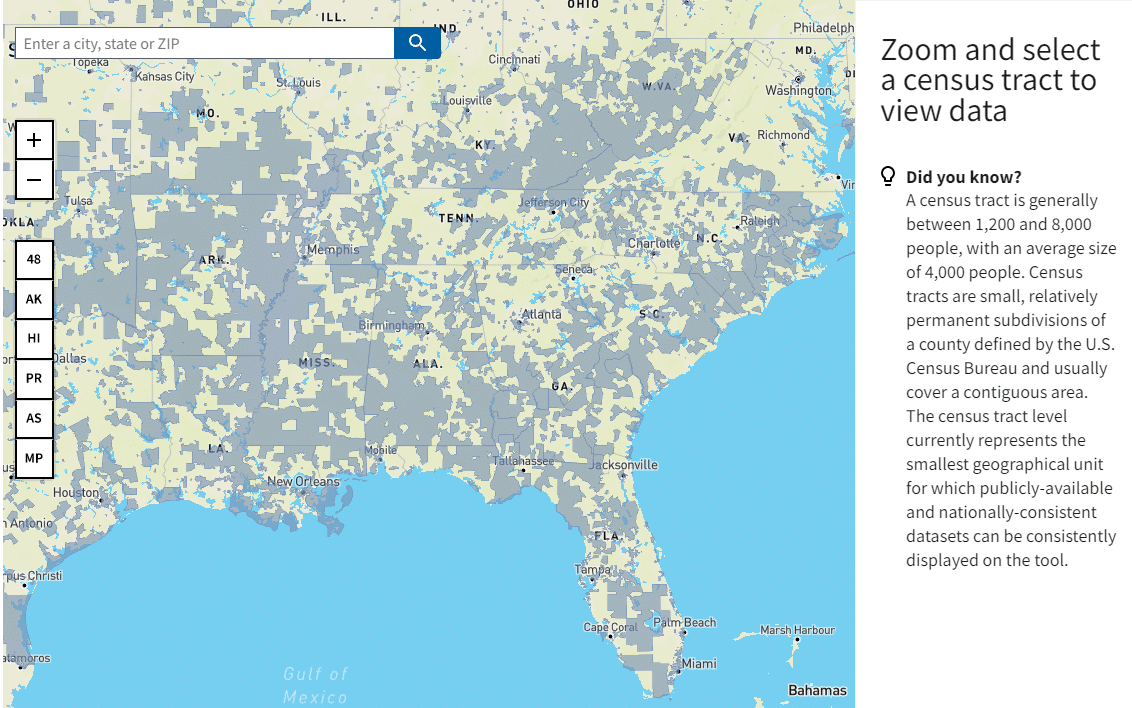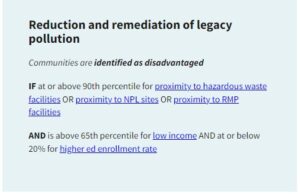 Jenny Black, Government Initiatives – Pensacola, FL
Jenny Black, Government Initiatives – Pensacola, FL
The Council on Environmental Quality Publishes a Draft Climate and Economic Justice Screening Tool
In mid-February, the White House Council on Environmental Quality (CEQ) released a beta version of the Climate and Economic Justice Screening Tool (CEJST). This tool was developed to help federal agencies ensure the benefits of federal programs are reaching disadvantaged communities.
How does this tool relate to the Justice40 Initiative?
In Executive Order 14008 on Tackling the Climate Crisis at Home and Abroad, President Biden directed the Council on Environmental Quality (CEQ) to create a Climate and Economic Justice Screening Tool. The goal of the Justice40 Initiative is to provide 40 percent of the overall benefits of certain Federal investments in seven key areas to disadvantaged communities. These seven key categories are: climate change, clean energy and energy efficiency, clean transit, affordable and sustainable housing, training and workforce development, the remediation and reduction of legacy pollution, and the development of critical clean water infrastructure.
What is the significance of this new tool?
 Until the release of the Climate and Economic Justice Screening Tool, the data indicators used to define a disadvantaged community were open to interpretation. In establishing the process for developing the beta version of the CEJST, CEQ incorporated recommendations provided by the White House Environmental Justice Advisory Council in order to ensure the highest quality tool that provides the public with full transparency on the methodology and datasets being used. This tool utilizes a formal, data-backed methodology for identifying disadvantaged communities that will be used by the federal government to guide future funding decisions. The current version of the tool provides socioeconomic, environmental, health and climate information and identifies communities that are disadvantaged on the census tract level.
Until the release of the Climate and Economic Justice Screening Tool, the data indicators used to define a disadvantaged community were open to interpretation. In establishing the process for developing the beta version of the CEJST, CEQ incorporated recommendations provided by the White House Environmental Justice Advisory Council in order to ensure the highest quality tool that provides the public with full transparency on the methodology and datasets being used. This tool utilizes a formal, data-backed methodology for identifying disadvantaged communities that will be used by the federal government to guide future funding decisions. The current version of the tool provides socioeconomic, environmental, health and climate information and identifies communities that are disadvantaged on the census tract level.
What data indicators are used to define a disadvantaged community?
 Communities are identified as disadvantaged by the current version of the screening tool if they are located in census tracts that are at or above the combined thresholds in one or more of the following eight categories:
Communities are identified as disadvantaged by the current version of the screening tool if they are located in census tracts that are at or above the combined thresholds in one or more of the following eight categories:
- Climate Change
- Clean Energy and Energy Efficiency
- Clean Transit
- Affordable and Sustainable Housing
- Reduction and Remediation of Legacy Pollution
- Critical Clean Water and Waste Infrastructure
- Health Burdens
- Training and Workforce Development
Each category includes a variety of datasets that were selected based on quality, relevance, and availability. The datasets seek to identify a range of impacts on communities including human health, environmental, and climate-related.
Link to the Tool: Explore the tool (geoplatform.gov)
Link to the Methodology: Methodology & data (geoplatform.gov)
Current list of Disadvantaged Communities: https://d3jqyw10j8e7p9.cloudfront.net/data-pipeline/data/score/downloadable/Screening_Tool_Data.zip
What other tools can be used to analyze areas that need assistance?
The EPA has also just released an update to EJ Screen, an environmental justice mapping and screening tool that provides EPA with a nationally consistent dataset and approach for combining environmental and demographic indicators. The new CEJST Tool and EJ Screen complement each other. While EJ Screen provides a tool to screen for potential disproportionate environmental burdens and harms at the community level, the CEJST Tool defines and maps disadvantaged communities for federal agencies to aid in guiding the benefits of certain programs. Together, these two tools provide a more comprehensive representation of community need.
What if I want to provide feedback on this tool before the final version is released?
To facilitate feedback on the beta version of the CEJST, CEQ issued a Request for Information in the Federal Register. You can also provide feedback straight from the CEJST website. Once CEQ has received and reviewed feedback on the beta version of the CEJST, the tool will be updated if deemed necessary.
If you are interested in learning more about how this updated tool can be used to strengthen your community’s brownfield grant proposal, please contact me or Trey Hess. We will be happy to help!
Contributed by:
 Jenny Black
Jenny Black
Government Initiatives
(251) 504-6943
jenny.black@ppmco.com
 Trey Hess, P.E.
Trey Hess, P.E.
Brownfields Redevelopment
(601) 953-2564
trey.hess@ppmco.com

